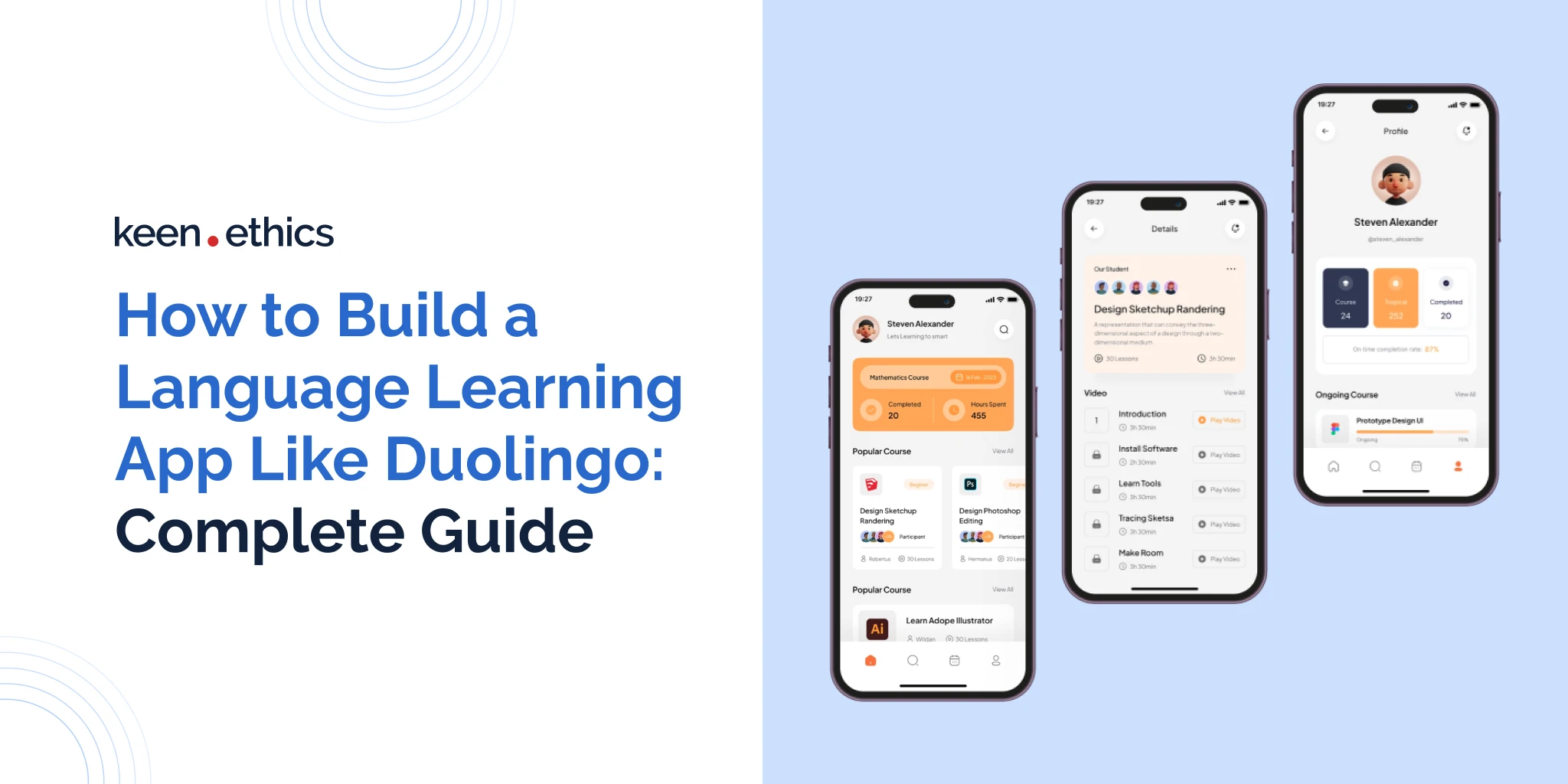Duolingo is undoubtedly one of the most notable language-learning apps on the market. It’s a leading online language learning platform, at least in terms of active users. For instance, it’s a popular solution for learning the Swedish language among migrants from Middle Eastern countries. Millions of people in countries such as the U.S. also actively use it to learn English once they migrate. Why is Duolingo so popular? We believe the key reason is its focus on a game-like learning model.
This platform and its competitors are far from perfect. As our personal experience shows, Duolingo offers users extremely strange phrases for translation (something akin to “sauce dances to rap”). This means it makes sense to create your own language app that will solve the problems of the current frameworks. In this article, we’ll look at the key ways to create an app similar to Duolingo. You’ll learn what features are necessary for such an app and, more importantly, what strategic steps are essential to achieve success.
What Are Some Language Apps Similar to Duolingo?
Among the language apps similar to Duolingo are Babbel, Rosetta Stone, Memrise, and HelloTalk. Babbel offers interactive lessons and exercises in various languages for mobile platforms, focusing on practical conversational skills. Rosetta Stone provides immersive language learning through multimedia content and speech recognition. Memrise uses spaced repetition and mnemonic techniques to help users remember vocabulary and phrases. HelloTalk facilitates language exchange by connecting users with native speakers for conversation practice. These apps aim to make language learning accessible, engaging, and interactive. How do they achieve this? Their key business model focuses on offering features like gamification, progress tracking, and community engagement. While each app has its unique approach, they all strive to help users learn languages effectively and at their pace.
How Do Language Learning Apps Like Duolingo Work?
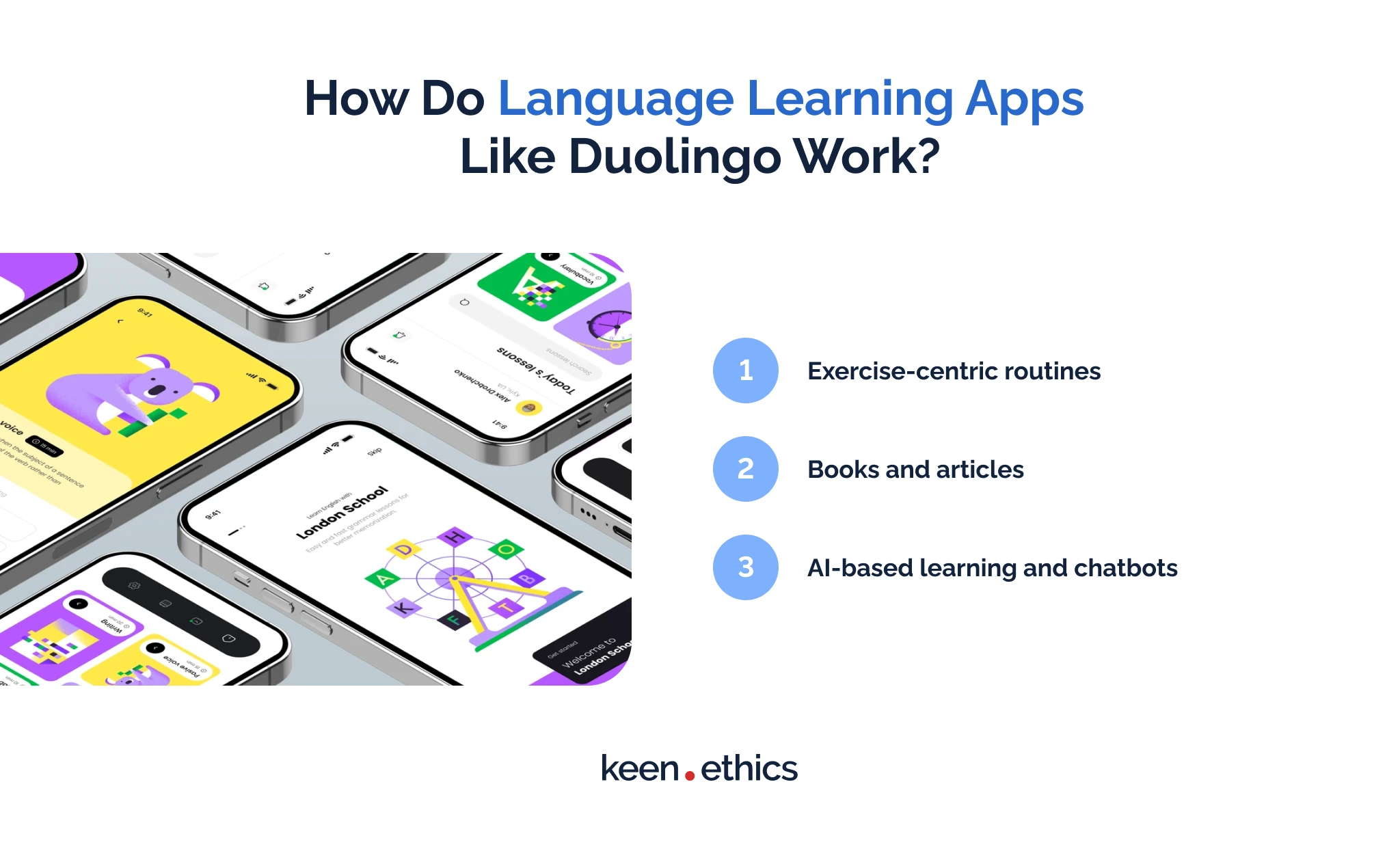
So, what features can make your language app similar to Duolingo in terms of format? Here are some of the key things making such apps work, in our opinion:
Exercise-centric routines
The first significant feature of language learning apps like Duolingo is their focus on exercise-centric routines. What do we mean by that? Instead of straightforwardly presenting issues such as grammar or vocabulary, they push the users to learn everything through exercises. A traditional approach to learning grammar and vocabulary is to write them down in a document and ask the individuals to memorize them by heart. Duolingo and similar apps don’t do this: they push the learners to study through practice. Yes, the learners will make a few mistakes, but they’ll memorize all the keywords and phrases in context. The idea is to create a learning process that doesn’t remind one of traditional school.
Video-, audio-, and image-centric content
Another vital element defining the promotion of knowledge in platforms such as Duolingo is their focus on multimedia content. What do they concentrate on? Firstly, one can expect that most exercises would have audio and even image support. What do we mean? If the app teaches you that ‘cheese’ in Italian is “formaggio,” it will pronounce this word to the user and, more importantly, provide an image of cheese.
This approach is one of the main ways in which Duolingo teaches the users through exercises. The users can see the relevant images and, more importantly, even look at translations of the words with clear pronunciation instructions. Some apps also rely on video content (Duolingo uses it minimally). One can find this content on platforms like Memrise. However, the idea isn’t different in such cases: these platforms also focus on the media content to teach the users through context rather than direct instruction.

Books and articles
When you create your own language app, it’s essential to consider the element that boosts the confidence of the users regarding their language skills. This element includes content for reading. Reading texts in a foreign language is a skill that is second in difficulty only to writing. The ability to understand texts is a perfect showcase of one’s skills. Furthermore, it’s important to have the relevant skills to learn new words and improve grammar knowledge. So, what should you do? Allow the users to read books and articles. A good idea is to adapt them to the needs of the average learners too. You can offer interesting non-fiction and fiction stories in a non-complicated format. This allows the users to learn something new regarding the world and perfect their language skills without encountering texts of excessive difficulty.
AI-based learning and chatbots
How to build a language learning app that adjusts to the user’s needs? The key framework is AI, artificial intelligence. Artificial Intelligence tools are notable for their ability to analyze vast amounts of data. This means you get an opportunity to feed information about the user activities to the relevant algorithms, and they’ll quickly produce a coherent learning program for them. In this respect, Duolingo Max (premium service), for example, is notable because it uses GPT4 to provide users with in-depth explanations of diverging grammatical and linguistic rules.
Another vital feature is “Role-play:” The users can communicate with ChatGPT within Duolingo to learn more about language-related context. While the use of these technologies is in a preliminary stage, we’re, most likely, bound to see a revolution in the upcoming years. All apps on the language market will be using AIs and chatbots. Duolingo already had some complex algorithms for teaching users: with AI, they can become personal.
Why Make Your Language App?
We believe multiple reasons exist to create your own language app. What are those? Here are the key factors:
1) There’s no similar solution specifically for audiences in your country. Some languages tend to differ from those spoken in Europe and America. In such a situation, the approaches apps use in one context can easily fail in different conditions. The common problem is that language apps only cover the most popular languages. You can create a language app to resolve these concerns with the existing list of languages. The idea is to give language-specific instruction and deliver learning opportunities for people speaking less ‘mainstream’ languages that, for example, rarely appear on social networks.
2) The existing solutions are inadequate from the standpoint of language learning. A big problem with solutions on the market is that they have some major downsides regarding their content. As we’ve mentioned, many people are critical of Duolingo due to its nonsensical texts (another good example is a phrase like this one: “dog uses the computer”). Creating a new product that doesn’t have this issue is a great business model. Most likely, many users would be willing to join such a service if it comes into being and offers enough content for language learning from the get-go. In many ways, the success of platforms such as Memrise results from the significant issues plaguing Duolingo.
3) You need a unique solution for your language learning business. One of the best ways to boost a modern language school is to create an app supporting its users during the learning process. The Duolingo model for such an app is likely to be good. Why? Many people who learn languages in private schools tend to have tense schedules. Traditional methods of learning are detrimental to their long-term progress. A Duolingo-like game-centric app is a strong solution to this problem. You can offer the users an opportunity to learn a lot despite spending a minimum amount of time. This arrangement is perfect for individuals who have to combine work with learning.
Step-By-Step Guide on How to Make a Language Learning App
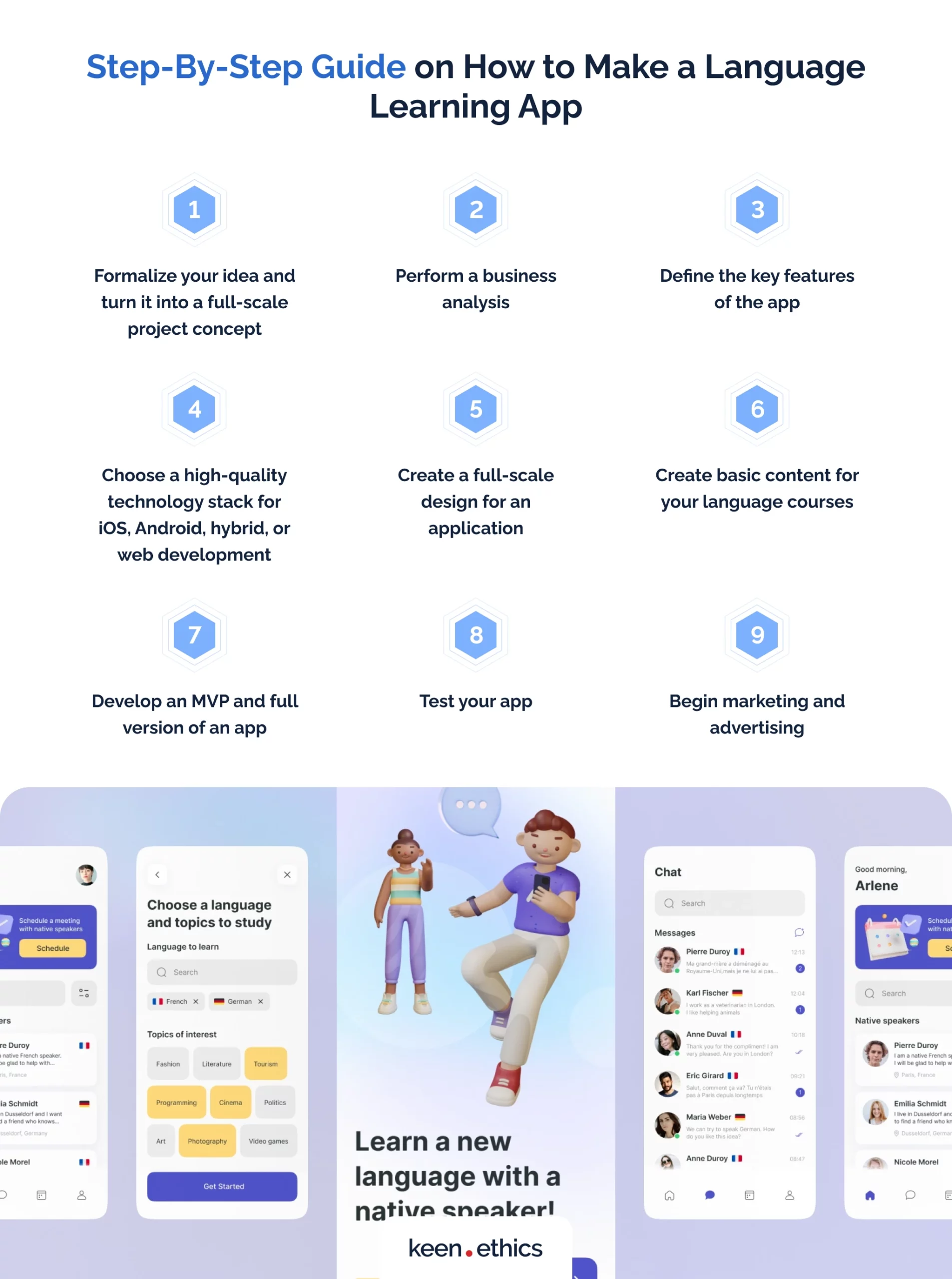
How to build a language learning app? This section looks at the key strategies you need to consider. As you’ll see, the key steps are diverse:
1. Formalize your idea and turn it into a full-scale project concept
The first thing you need to do during the project creation is to deliver a full-scale project concept. If you’re reading this article, you likely have an idea in mind. It can encompass numerous potential business frameworks. When you want to create a firm, you have to take this idea and manifest it into some business concept. Answer yourself how this business will work and what potential monetization models you can use.
2. Perform a business analysis
A second major step to consider when you make your own language learning app is to perform a full-scale business analysis of your idea. It’s not enough to have a concept: you must also see if it’s feasible. According to Timothy Carter, writing for Entrepreneur, 20% of businesses fail in the first year. 50% fail in the first five years of their functioning. However great your idea is on paper, you have to understand it may fail to fit the reality of the market. If you’re interested in analyzing your business idea, don’t hesitate to contact us. We can offer a free estimate of your concept for an education-oriented business.
3. Define the key features of the app
Once your idea is well-validated, you should transition to the brainstorming phase. It’s crucial to outline all the key features of your app and decide on the functions, productivity, and security requirements you’ll have. For instance, if you want to create an app like Duolingo, it’s essential to understand what features you seek to inherit and which ones require a major change. Exercise-based learning can stay, but you may want to focus on the more realistic content. Try to be as detailed as possible. All this information would later be central for developers working on your app. The more you analyze and the more you approximate, the better.
4. Choose a high-quality technology stack for iOS, Android, hybrid, or web development
Finding a high-quality tech stack for any of the tasks mentioned below is important if you want to achieve success. How to build a language app that works well? Use the tools that allow you to maximize the benefits of diverging platforms. Let’s review some of the key technologies you need to consider while doing this part of development work:
iOS development tools
For iOS app development, the primary programming language is Swift. Swift is a modern and powerful programming language developed by Apple specifically for iOS, macOS, watchOS, and tvOS. To write iOS apps, developers use Xcode, an integrated development environment (IDE) provided by Apple. Additionally, developers leverage the iOS Software Development Kit (SDK), which delivers a set of libraries, frameworks, and APIs to access the native capabilities of iOS devices. As you can see, development for iOS primarily concentrates on native platforms.
One of the key reasons why Apple apps are so seamless during everyday work is the reliance on internal development tools. Apple made everything to ensure developers have as many instruments for creating native apps as its internal specialists. Native platforms such as Swift aren’t the only choice for improving app development rate, however. It’s also possible to engage in cross-platform development, which we’ll discuss in the hybrid options. The instruments there allow one to provide apps both for iOS and other platforms at the same time.
Android development tools
Android app development can be done using either Java or Kotlin as the programming language. Java has been traditionally used for Android development, while Kotlin is a newer language that offers more concise syntax and increased productivity. Android Studio is the official IDE for Android development, providing a comprehensive set of tools, an emulator for testing, and seamless integration with the Android SDK. The Android SDK delivers various APIs and libraries to interact with device features and create rich Android applications.
As you may see here, Kotlin is, essentially, Google’s attempt to create an alternative to Swift. In our opinion, the approach of Google is superior to that of Apple in terms of app promotion. Why? Java and Kotlin are both compatible with other platforms (specifically, Kotlin compiles in Java environments). This means porting an app from Android to iOS or PC is much easier based on Android rather than Apple tools.
Hybrid development tools
Hybrid app development allows building applications that can run on multiple platforms using a single codebase. This is perfect for education application development. Node.js and React Native are popular frameworks for hybrid development. They use JavaScript as the programming language and enable developers to build native-like mobile apps using reusable components. React Native offers a rich set of pre-built UI parts and allows seamless integration with native features. Node.js gives the developers an opportunity to create the backend of diverging apps in JavaScript, allowing for a full stack experience.
The number of development tools for those platforms is large. Some options include Cloud9, Koding, and Visual Studio Code. Radix company, which specializes in such solutions, has a long list of tools that can be useful. We at Keenethics also focus on developing Node.js and React.js apps. If you’re interested in the services of a company with eight years of experience in the field, don’t hesitate to contact us. We can offer you insights on cross-platform development and even deliver an app according to your requirements.
Web development tools
Web development is about building applications that run in web browsers. For frontend development, developers use HTML (HyperText Markup Language) to structure the content, CSS (Cascading Style Sheets) to define the visual presentation, and JavaScript to add interactivity and dynamic functionality to web pages. Backend development typically involves using a framework like Node.js (JavaScript-based) or Ruby on Rails (Ruby-based) to handle server-side logic, database interactions, and API integrations. Databases like MySQL or MongoDB commonly store and retrieve data in web applications.
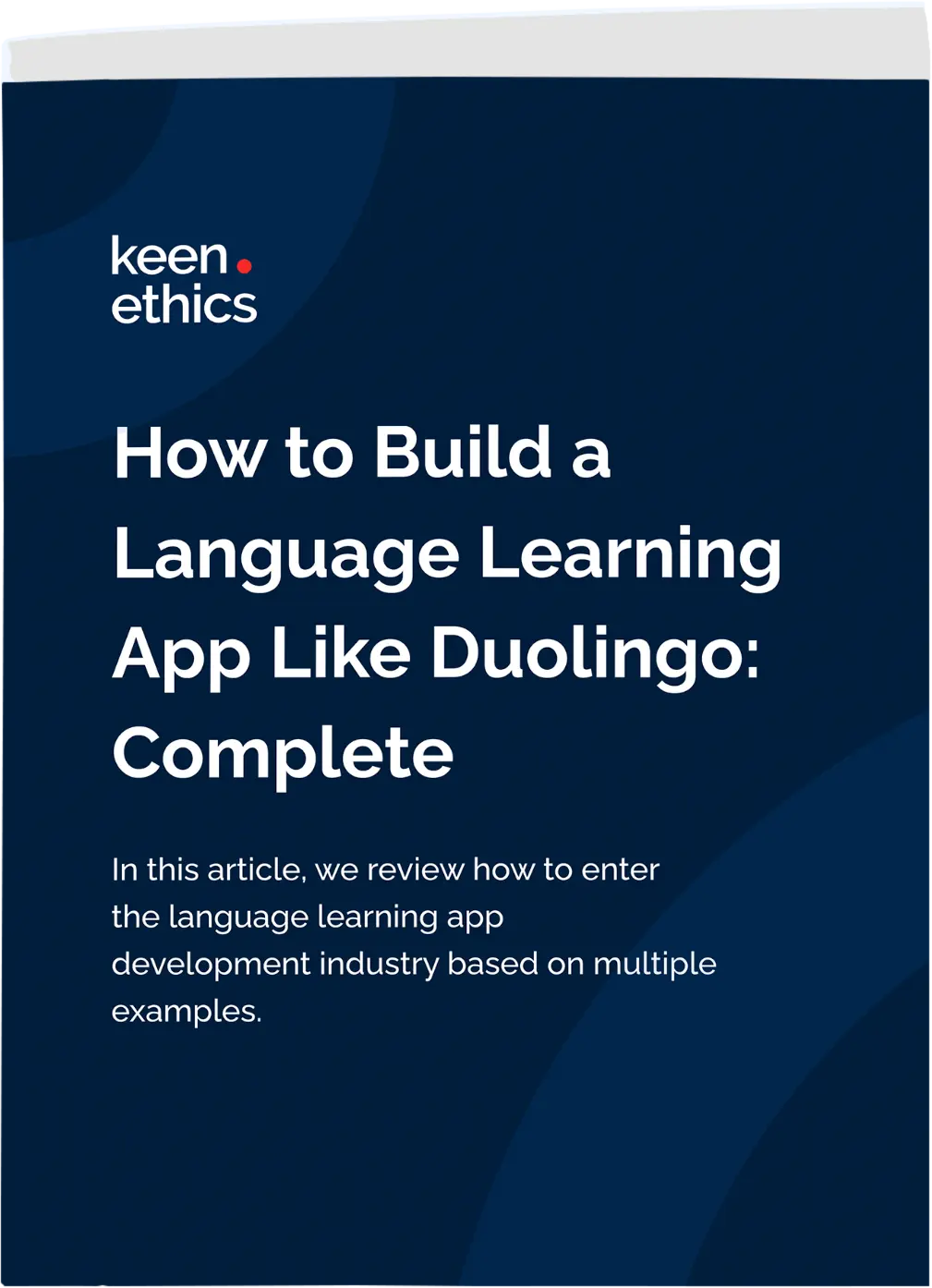
5. Create a full-scale design for an application
Before you proceed to development, it’s crucial to understand how the interface design of your app would work. Many apps fail despite great ideas because they don’t offer a comfortable interface. What should you do at this stage? Create wireframes and then use internal testers to receive a judgment on their efficiency. The more variables you analyze at this point, the better. Having multiple possible interface options is liberating because you won’t be out of choices if the general audience doesn’t like your approach.
6. Create basic content for your language courses
Learning content is an essential part of any app like Duolingo. To a great extent, it’s more important than any other aspect. A great interface and code can’t save an app without a good lesson structure. You have to ensure your language learning lessons are great from all standpoints. They must be interactive, full of multimedia, and should teach through practice rather than theory. If you understand that your app doesn’t offer any unique content to the users, it’s better not to continue development. Competition in the learning app sector is, to a great extent, content-centric.
7. Develop an MVP and full version of an app
After agreeing upon all aspects of app development, it’s time to transition towards development itself. What’s our recommendation here? In our opinion, the best choice is to start with a so-called Minimum Viable Product (MVP). It’s a version of an app with a minimum possible number of features. The idea is to make it usable enough for the market. Using such an approach, you can save funds and test if your idea works for the general audience as early as possible. If an MVP is successful, it may be a good idea to transition toward a full-scale release. It’ll have all key quality-of-life features and minimize the number of bugs.
8. Test your app
Before releasing and even after doing so, an important step is to test your app as much as possible. What should you do at this stage? Hire Quality Assurance specialists to ensure there’s a minimum of errors. TechRepublic reports that software failure caused 1.7 billion dollar financial losses in 2017. The current statistics are likely even more devastating. Lack of testing led to major failures in the software world, such as the infamous Windows Vista. This operating system continues to top the lists of the worst solutions on the market. Many gamers still remember the launch of Cyberpunk 2077, which faced problems with testing, as one of the most disastrous moments in gaming history.
9. Begin marketing and advertising
With the release of your app, it’s crucial to transition toward marketing and advertising. What should you do at this stage? Choose the key features of your app and promote them among the wider audience. In our opinion, a good choice is to focus on the features noted as potent by the users themselves. A common problem for any marketing analysis is that sometimes it doesn’t consider the elements capable of attracting users. Marketing specialists are good at predictions. Sometimes, however, predictions are far from being accurate about the real wants of the clients.
Must-Have Features for Creating a Language App
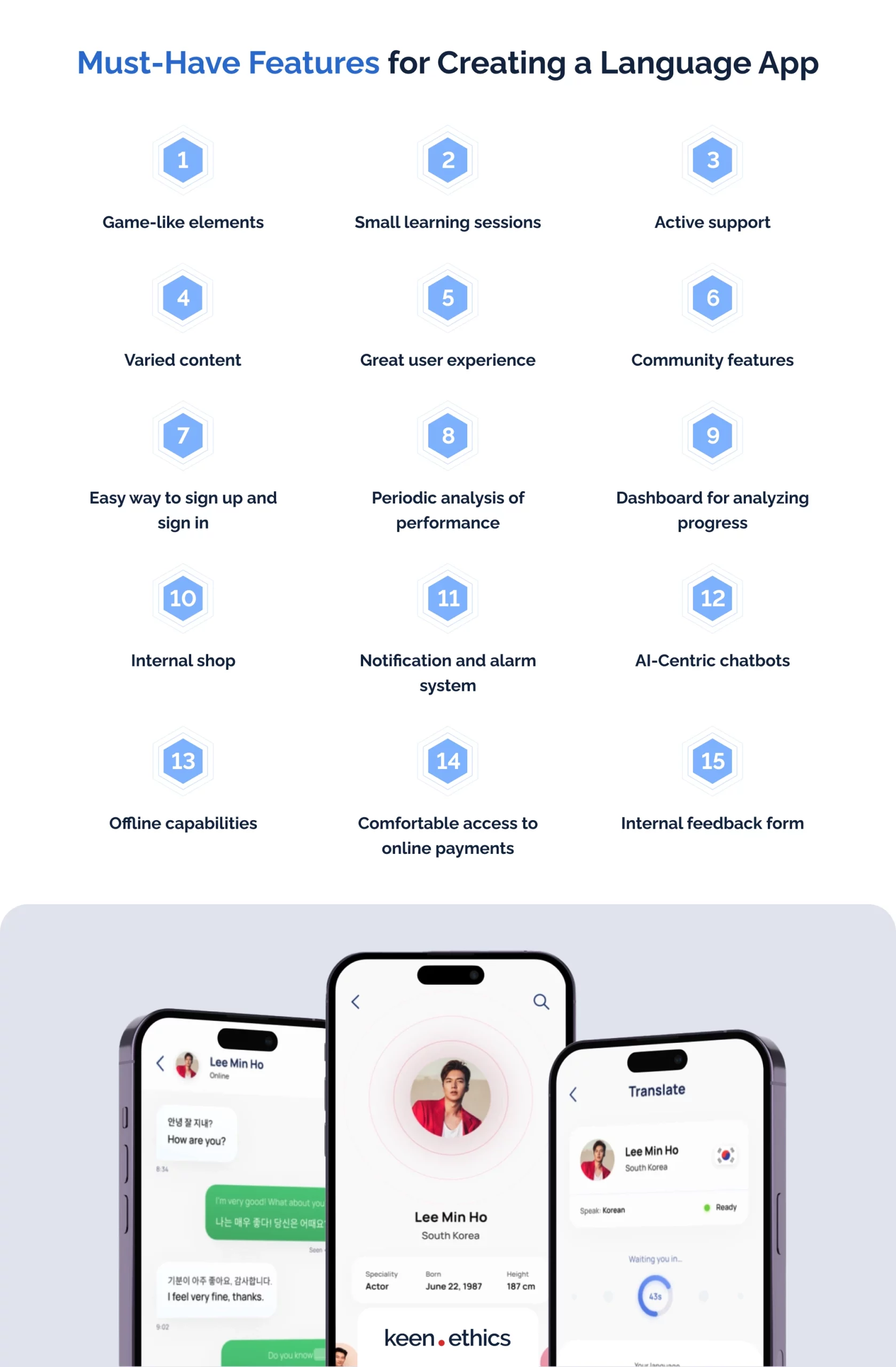
All language apps can benefit from a wide range of features. How to create a language learning app that delivers a maximum number of benefits? Take a look at the following list of features to understand what functions can make or break your product:
Game-like elements
Implement gamification elements such as badges, points, leaderboards, and rewards. In this way, you can make the language learning experience more engaging and motivating for users. How? They’ll get an opportunity to turn their learning into a game where they compete against their past results and other “players/learners.” Many people don’t like learning but like games. Gamification is a perfect opportunity to capitalize on this psychological feature of humans.
Small learning sessions
Break down the language learning process into bite-sized, easily digestible modules or lessons. Provide short quizzes, flashcards, and interactive exercises that allow users to learn in small increments. Why is this important? Such an approach is crucial for maximizing retention and enabling them to fit learning into their busy schedules. Many people can’t dedicate more than 15 minutes a day to learning. Respect this factor, and potential users will gladly join your service. Simplicity is the pathway to perfection!
Active support
Offer step-by-step guidance and support throughout the language learning process. Provide hints, tips, and explanations to assist users when they encounter difficulties. Language learning after the age of 17 becomes more challenging. While it’s possible to achieve fluency in all aspects for adults, the amount of effort grows after this stage, according to Monika Schmidt (Professor of Linguistics, University of Essex). Active support helps the learners overcome the inevitable hurdles in their everyday learning. You can highlight the pain points one needs to consider. A good idea is to make learning data-oriented: one can collect data about the challenges of learners in similar age groups to help them overcome the common barriers in language learning.
Varied content
Provide diverse content and activities such as vocabulary exercises, grammar lessons, speaking practice, listening exercises, and cultural insights. Why is offering a variety of content so important for the long-term success of a language app? In our opinion, the answer is simple: it keeps users engaged and allows them to explore different aspects of the language. Many people leave great jobs because they’re monotonous, choosing something more adventurous instead. This choice is life-changing. Imagine what would happen to your app if it’s monotonous. Most likely, the users will quickly start avoiding the solution and create a bad reputation for it.
Great user experience
The key characteristic of many language learning apps is that they’re used by people who lack time. A bad user experience and interface can push those clients to waste their time on configuration. In this light, many users would be unwilling to forgive your app for such a transgression. How to create a language learning app that satisfies a maximum number of users? In our opinion, the following steps are crucial for success:
1) Create an intuitive and visually appealing design with a user-friendly interface.
2) Ensure easy navigation, clear instructions, and a clean layout to provide a seamless learning experience. The users should face minimum barriers while trying to access lessons and track their progress.
Community features
A big aspect of successful learning is the ability to achieve a sense of community. Many people fondly remember their school and university years because they had an opportunity to encounter great people there. Language apps are isolated in this regard, but we see some options for making them community-oriented too. So, what are your opportunities here? You should enable the learners to interact, share experiences, practice conversations, and receive feedback from native speakers or fellow learners. A good way to do this is by providing a place for communication, such as a forum. We also recommend chats and, potentially, communication tools for people who compete within certain game-like features of your app.
Easy way to sign up and sign in
If your app provides interesting features, many people would be willing to try it out. The key task here is to remove any barriers to their attempts at accessing some key features. What is the best way to approach this issue? In our opinion, you should offer a straightforward and hassle-free sign-in process, allowing users to create accounts using email, social media, or third-party login options. Many people already have access to other services. By allowing the users to use them during registration, you minimize their efforts. In apps like Duolingo, one can register in one minute if they have a Google account, for instance. We believe that mimicking this feature is always a great idea.
Periodic analysis of performance
Common sense shows that the best way to study something is to be disciplined about it and learn the relevant material periodically. Spaced and continuous repetition is, for example, the basis of famous learning-oriented apps such as Anki. What does this mean for your language learning app? In our opinion, you should include periodic assessments or quizzes to evaluate users’ progress and proficiency. These assessments can provide personalized feedback, identify areas for improvement, and adapt the learning content based on users’ performance. The tasks must also be periodic to enhance the nature of assessments. If a person learns daily, they have the greatest chance of success regarding language learning.
Dashboard for analyzing progress
Modern language learning apps are notable for the tremendous amount of information they collect. This means the presented software can help the users with creating detailed statistics and, on their basis, with better learning plans. The best way to use this power is to give users detailed insights into the key data. In this respect, we recommend you to develop a comprehensive dashboard that allows learners to track their learning progress, view completed lessons, monitor their performance, and set goals. This visual representation of progress motivates users and helps them focus on their language learning goals. If your app is customizable, such information is even more useful: the users get an opportunity to choose the amount of pressure they’ll encounter in their everyday work.
Internal shop
Many apps like Duolingo offer unique currencies as a reward for user activities. In the case of Duolingo, the users gain so-called lingots, for instance. How can you use them? Use those tools to their full potential by letting people spend this currency on unique items. We believe that these shops are especially effective if you give content that is exclusive to rewards such as lingots. The ability to buy apps from a premium shop will immediately notify others about the learning successes of a person, for example. So, what should you do? In our opinion, the best option is to integrate an in-app shop where users can purchase additional learning resources, such as premium lessons, vocabulary packs, or audio recordings.
Notification and alarm system
As we’ve already mentioned, many users of language-learning apps tend to be extremely busy. This means they sometimes forget to do some exercises due to being overloaded with work. In our opinion, you should use push notifications to send users reminders, updates, and personalized learning recommendations. In this way, you can inform them about changes and remind them of the need to learn something. Even the most high-pressure jobs have moments when a person can learn. Notifications are perfect for reminding people they should combine learning with their intense schedules.
AI-Centric chatbots
The topic of AI has already received attention from us in the sections above. This technology is undoubtedly the future of learning. So, this means you should incorporate an AI-powered chatbot tutor that can answer language-related questions, provide explanations, offer conversational practice, and deliver feedback. This feature allows users to have instant support and simulate real-life language interactions. An AI automates many of the common feedback tasks the users encounter. Don’t miss an opportunity to use this technology.
Offline capabilities
Many people using language learning apps sometimes end up without the Internet. If you work in a rural area, such situations are especially common. This means you should enable users to download lessons, exercises, or audio content for offline access. Since learning should be, more or less, uninterrupted to be successful, offline capabilities are essential if you want to attract adult learners to your app. The requirement for constant Internet connection is a major turnoff for many people outside urban areas.
Comfortable access to online payments
Most people in developed countries use online payment systems, such as PayPal, to perform purchases. As Oberlo, a major drop-shipping company, notes, PayPal has over 220 million users. Other platforms likely encompass tremendous numbers of people too. So, what should you do with the payment frameworks? In our opinion, the key goal is to integrate secure online payment options for users to subscribe to premium features, access exclusive content, or remove ads. Streamlined and secure payment methods enhance user experience and provide monetization opportunities for the app. The easier it is to pay, the higher the likelihood that many people would be willing to use your app.
Internal feedback form
How to create a language app attracting a maximum number of users? Consider their interests as much as possible. How to do this? Listen to those individuals and incorporate their feedback into the design of the relevant app. The best way to do this is to include an in-app feedback form or surveys to gather user suggestions and bug reports. Such an approach is important because it helps in the continuous improvement of the app and addresses user concerns through the implementation of novel features.
Contact our company to assess your business idea and start developing a product of this type!
Challenges in Language Learning Apps and Technological Solutions
How to build a language app with minimal problems? You should have good knowledge of the potential challenges that befall the creators of such apps. So, what issues should you look at to prevent long-term problems with your app? Here’s the list of the key things you need to consider:
1. Problems with student motivation
The first major issue modern developers encounter is the lack of student drive. Among the best ways to ensure the long-term success of learning is the focus on continuous effort. If a person studies every day, they have the greatest chance of achieving significant success. What’s the problem with this framework? It requires a lot of discipline and, more importantly, motivation. The difficulty is that maintaining drive is difficult. Our work lives are stressful, and breaking the learning streak is easy. One needs to create such a framework for boosting motivation that would help users overcome these barriers. In our opinion, the answer to this concern lies in combining gamification approaches with diverging notification systems. Other innovations are also welcome.
2. Engaging all key linguistic skills
Apps like Duolingo tend to be exercise-centric. In such conditions, creating a basis for covering all linguistic skills is difficult. While grammar, vocabulary, and audio exercises are easy to imagine, writing and reading are much more difficult to incorporate into such systems. These two skills most likely need separate approaches outside the exercise-focused frameworks. For example, a good idea is to add books into the system. As for writing, you can use modern AI chatbots to check if the users deliver grammatically coherent texts. This approach won’t solve all problems inherent in automated language learning apps, but it can at least add some customization for reading and writing tasks.
3. Preserving knowledge
A big problem of systems focusing on bite-sized lessons is that information from them is easy to forget. The reason is simple: this lesson format disrupts the ability of the users to understand the full structure of a language. Bite-sized lessons are great for people with time constraints. However, they don’t teach them how certain languages work. There’s no full understanding of their grammar and vocabulary. To overcome this challenge, modern tools, such as Duolingo, most likely, need to focus on the larger picture. Some introductory theories in the same bite-sized format can put a lot of knowledge in context and improve the capability of the learners to retain information. It’s crucial to tell the learners “why” they should do particular things rather than simply show them in action. The bite-sized format is great, but it needs context.
4. Language barrier: Small number of languages covered
The final problem with many language apps is that they tend to have problems with language integration. Even apps like Duolingo feature only 40+ languages. This issue can create a massive language barrier: users who want to learn a non-mainstream language may have to learn English first, for example. In this situation, the language barrier is one of the biggest difficulties for the mass adoption of language apps like Duolingo. What should you do to work with them properly? We believe modern AI tools are the first step to high-quality automated translations that can make different courses available to a wide audience. Don’t hesitate to use them to improve your service and attract more people from countries that are potentially outside your target groups.
How Much Does It Cost to Create a Language App Like Duolingo?
It’s impossible to say how much a language app like Duolingo costs without considering your unique needs. Some clients have small apps in mind. Others want to develop large-scale projects with many features. The cost of development differs radically between small and large products. A small project can start with 15000 dollars. A large one may cost hundreds of thousands, if not millions of dollars. If you would like to understand the overall costs of your project, a good idea is to address specialists. Every learning app development cost is unique. We at Keenethics offer free estimates of the project costs to help you understand if the choice to create your own language app is worth pursuing with your current resources.
Please note that this is an estimate based on the information provided. The actual cost may vary depending on the specific requirements and complexities of your project. Start planning your software project today with our cost estimator.
How Long Does It Take to Build a Language App Like Duolingo?
The time required to make your own language app like Duolingo can vary depending on several factors. It typically takes multiple months to a year to develop a basic app version with core features, such as course creation, user registration, and progress tracking. However, the process of building a comprehensive app like Duolingo can take many years. The reason for this phenomenon is simple: apps like Duolingo have a complex set of features. They include many languages, gamification elements, speech recognition, and community tools. Generally, the following factors influence the development time of an app:
1) The complexity of the design: features similar to Duolingo offerings can take years to develop;
2) The size of the development team: if two people develop a small app, it’ll take longer to produce than with a team of five specialists;
3) The availability of resources: having enough resources is also a big issue. If the client runs out of money for a project, pauses in development are inevitable until they find other monetization sources for e-learning app development.
All in all, the development process for a language-learning app like Duolingo depends on many factors.
Best Practices for Monetizing Your Language Learning App
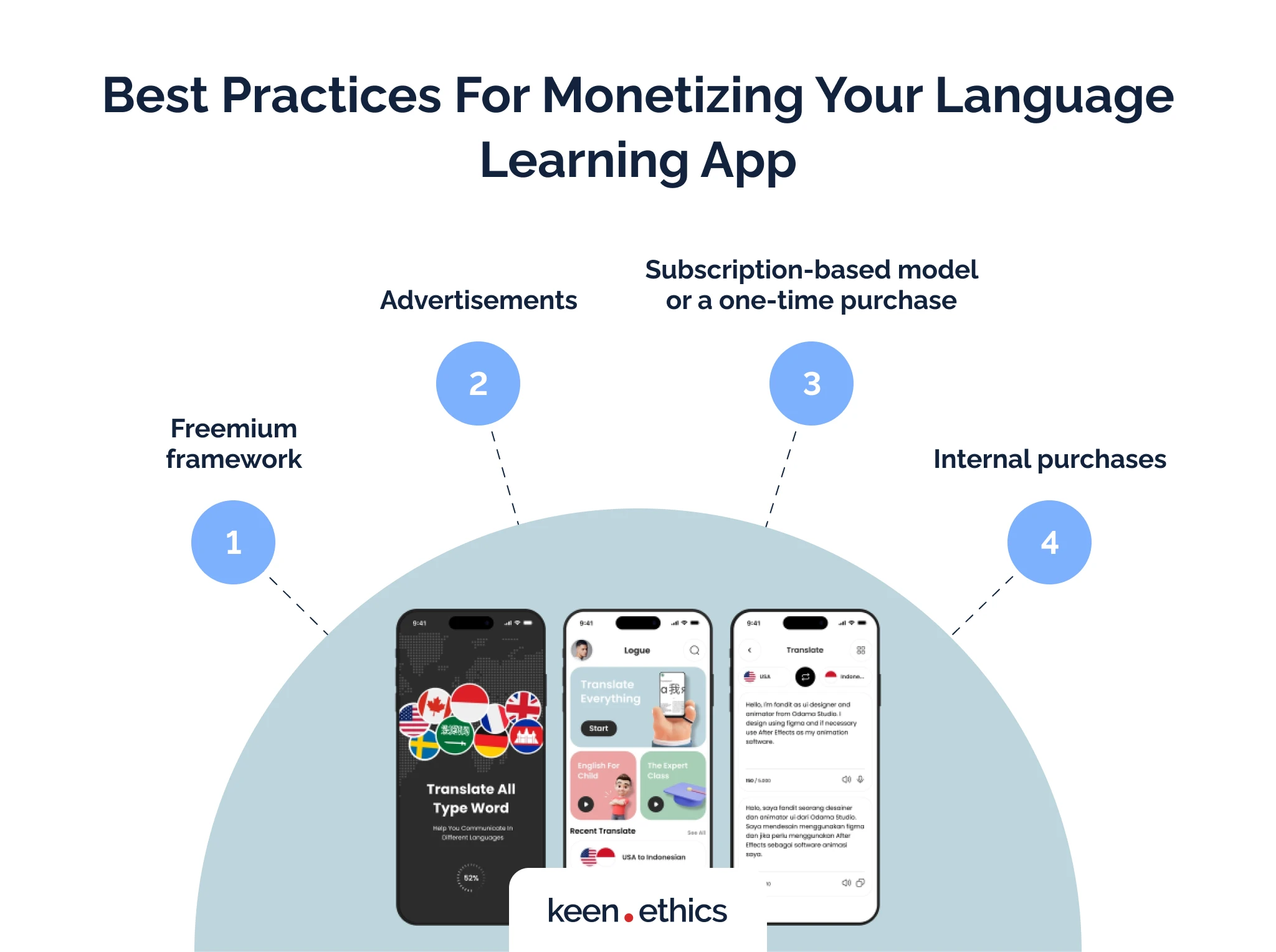
How to make a language learning app that’s successful financially? Here are the key approaches you should consider for monetizing your project if you work for an education app development company:
1. Freemium framework
The freemium model is one of the most popular frameworks for monetization used on the market. What does it entail? The clients who use the app for free get access to the basic features of the app. In turn, if the user pays for a premium subscription (a one-time payment is also possible), they get access to unique payment-only features. Duolingo is currently using this model in its business. The users can learn languages for free, but to get access to AI and advanced repetition features, they have to pay for the premium version of the relevant software. This model works especially well with advertisements. If you offer extensive features to free users, you can still earn funds from their participation in your ecosystem by displaying advertisements.
2. Advertisements
A major approach for making money on mobile apps is the usage of advertisements. You can show them to the users after lessons or a certain number of interactions with the app. Many advertisers pay significant sums to showcase their products. Both Apple and Google care about advertising capabilities and offer diverging features to simplify their use. This model works in perfect conjunction with the so-called freemium approach. You can show advertisements to users outside your premium program. In this way, you can earn funds from all users (both paying and non-paying ones).
3. Subscription-based model or a one-time purchase
You can also offer the users an opportunity to pay for your app before using it. A one-time purchase is great if your app is low-cost, and you don’t need to support it a lot. In a Duolingo-like case, this won’t work, however: to succeed, one must expand the content. Above all, you should try a subscription-based learning model to cover the costs. In it, the users pay a certain sum every month to get access to the app. If you manage to collect a sizable group of learners, this model is among the most lucrative. Still, we believe that the freemium approach is superior. The showcase of free features is the best way to convince users to consider your app.
4. Internal purchases
The final way to monetize your e-learning app is to deliver some in-app purchases. They can work with any model out there (even though subscription users will likely see it in a more negative light). What’s the idea behind it? You can provide courses or cosmetic content (virtual clothing for the in-app avatar of the user, for example) for a separate payment. This approach gives users a choice regarding content and allows them to select if they want to see some content. Is this model fair? Yes! If you deliver unique courses via it, this approach may be a perfect way to remunerate the creators. Subscriptions and advertisements can sometimes be insufficient to create high-quality content for a long time and fund app maintenance in an e-learning app like Duolingo.
How Can Keenethics Help You?
All in all, the information above should be more than sufficient to help you with creating language learning apps. Are you interested in professional assistance with your app idea? Do you want to build an e-learning app like Duolingo? In that case, don’t hesitate to contact professionals. We at Keenethics have eight years of experience in developing web and mobile products. How can we help you? Our specialists can deliver a free estimate of your project costs, perform a UI/UX audit, and, of course, assist with developing and testing a software product. Don’t hesitate to contact us today: we know how to provide a high-quality service for you.
FAQ
What’s the average cost of creating a language learning app?
The average cost of developing a language learning app ranges from $15,000 to $500,000, depending on the app’s complexity and features. Occasionally, an app can cost millions of dollars if one considers expenses on course creation and long-term support.
Can I make a language learning app profitable?
Yes, it’s possible to make a language learning app profitable through various revenue streams such as subscriptions, in-app purchases, and advertisements. Even though Duolingo is currently incurring financial losses, experts expect that it will become fully profitable in 2024. A less ambitious app is likely to start being profitable even faster: Duolingo has an aggressive expansion model.
How to produce an app like Duolingo?
To produce an app like Duolingo, you would typically need to gather a development team, create a detailed plan, and engage in software development and design processes.

